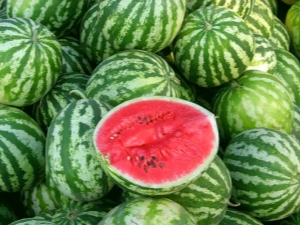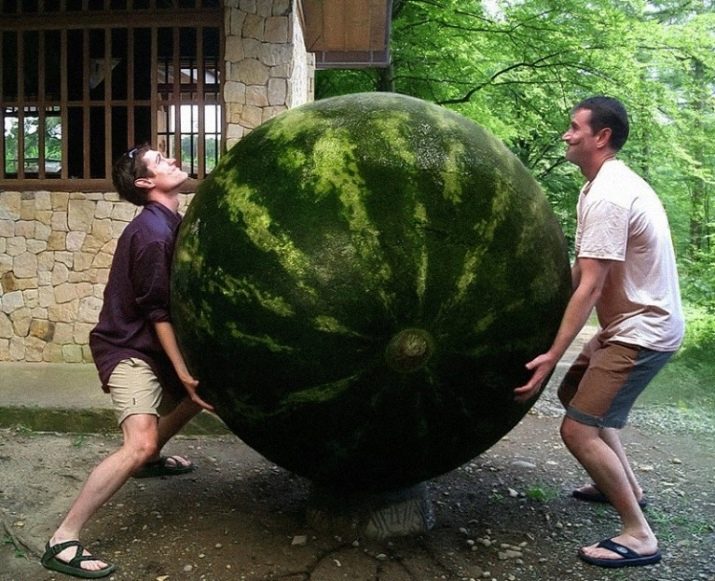What is the biggest berry in the world?

When the word "berry" the first associations usually occur with some small fruits such as currants, for example. However, more experienced people who have repeatedly asked such a question will surely remember a watermelon. It is possible that there are larger fruits in this category.
What is considered a berry?
For a start, let us see what is related to the concept being described, otherwise there is a risk of missing something important. According to the botanical definition, the so-called fruit with a thin and relatively stiff skin with a much more juicy, often even watery core. The number of seeds is usually quite large, although some fruits with two or even one seed are also included in the berries. Often these fruits grow on grassy or shrubby plants, although there are exceptions.
The berries include not only watermelons, but also many other garden crops, which are considered to be vegetables in our country. Pumpkins, melons, cucumbers, not to mention tomatoes - all of these fruits are quite suitable to take full part in our ranking.
There is also such a thing as a false berry. In this case, the apparent fruit is formed with the participation of not only the ovary, but also some other parts of the plant, usually receptacle. A characteristic example of a false berry is raspberry, which everyone would call a berry, although, in fact, it is ... a nut. It would be more correct to say that what we consider as one fruit actually represents a multitude of fruits: each grain of raspberry is a separate nutlet.
A similar situation is also observed with strawberries and wild rose hips. Such fruits are not really berries, therefore they are not included in our rating. However, the size of individual copies of such a crop still does not reach the same watermelon or at least a tomato, so they would not claim leadership anyway.
Absolute winner
If you think that the largest berry in the world is a watermelon, then you, of course, are right. South Africa is considered the birthplace of this plant in the wild - there and today its wild-growing fruits with an average weight of only 250 g are found. But today the situation is quite different.
For centuries, breeders of different civilizations have worked to increase the size of this fruit, and modern conditions of care and fertilizer only contribute to this.
Watermelons came to Russia through Iran, and the name, by the way, also came from there. Interestingly, in the local language "Harbüz" means "a cucumber the size of a donkey," although the Iranians, of course, meant a poetic comparison: a real animal weighs a lot more. Today, this berry is grown everywhere, and such countries as China, Turkey, Iran, Egypt and Russia are leading in the list of main producers.
As for the world record, it was set in the States, namely in Louisiana. Here, local farmers managed to achieve a truly amazing result, because the fruit of their efforts was delayed by as much as 120 kilograms! The Russian record is much more modest, it was staged in 2009 and stopped at 61.4 kg. The Russian record is also European.
Nominees
Surely many readers thought that the watermelon won the berry competition with a huge margin, but in fact it is not so - competitors are literally pressing out, and in each new year there is a chance to get a new champion. Consider briefly a few more applicants for our title.
- The closest rival of the watermelon is its relative - pumpkin. The average size of a large pumpkin is up to 50–70 kg, which probably makes it the largest in average, but the model pumpkin giant didn’t reach the absolute record of anything: it had a weight of 119.5 kg. The record fruit of this technical culture was able to grow in Belgium.
- Practically does not lag behind their close relatives and melon. Its average size is a very modest 1.5-4 kg, but farmers who are aiming for a record are ready for anything, and the result can be a fruit weighing as much as 118 kilograms! Such a giant, grown in the USA in 1985, had an oblong shape, and its length was three-quarters of a meter.
- Not very honorable fourth place is a variety of pumpkin, known as zucchini. It is much inferior in size to all three prize nominees not only in medium size, but also in terms of the world record: the largest copy had a mass of “only” 65 kg. This achievement was a British farmer in 2008.
- The top five in most ratings closes a pineapple. It is wrong to regard it as a berry, since it essentially consists of many small fruits, but it is included in the lists due to the impossibility of dividing it into small separate parts. A special record on the part of the pineapple is not fixed, but it is known that they can reach about 15 kg.
- Next come the "small" fruits - so, in sixth place is located a tomato. Tomatoes are considered large, if they reach a weight of more than 100 grams, because the achievement of Gordon Graham in the form of "berries" weighing 3.5 kg should inspire respect. The bush, on which this miracle grew in 1986, rose to a height of 16 meters.
- Eggplant Many readers will call it larger than a tomato, but the record here is relatively modest. The largest sample weighed just under 1.7 kg. The achievement was submitted to a woman from Krasnodar region.
- With cucumber, also included in our rating, is a special situation: the largest here is determined not by weight, but by length. This record was also set in Britain, where the green berry rose almost 92 cm in length. For a fruit with an average weight of 100 grams, this is an amazing amount.
- Garnet found himself in a situation similar to the one that happened with a cucumber - its record is not measured in kilograms, but in centimeters. The title went to the Chinese, who raised a fruit with a diameter of almost 49 cm (on the shelves of fruits, the diameter is usually about three times smaller). For the sake of justice, it should be noted that such a fruit is also not quite a single berry.
- Close the top ten, according to various sources, kiwi, fig or feijoa. They are not very large and the difference between them is small, so the records are not fixed and can be updated almost every year.
On the beneficial properties of the largest berries in the world you will learn from the following video.


























